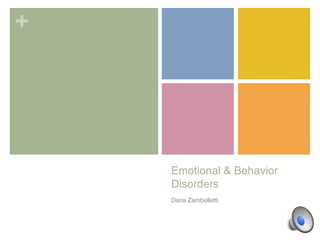
Emotional behavioral disorders
- 1. + Emotional & Behavior Disorders Dana Zambelletti
- 2. + What are Behavioral & Emotional Disorders? “…a condition exhibiting one or more of the following characteristics over a long period of time and to a marked degree that adversely affects a child’s educational performance” Code of Federal Regulations, Title 34, Section 300.8
- 3. + Characteristics Disrupts classroom activities Distractible or inattentive Does not follow classroom rules Demonstrates aggressive behavior Difficulty working in groups Low self esteem Poor concentration Often manipulative of situations Difficulty applying social rules related to others personal space Resistance to change or transitions
- 4. + Rationale Personal interest in topic Observed various behavior plans in field work experience
- 5. + Current Problem and Need Different plans in use Are they effective? Is there a way to incorporate technology? Goal is to improve students access to education
- 6. + Steps of the Study Research various behavior plans currently in use Focused on middle school level Observe behavior plans currently in use in my middle school Compare research to observations Research ways technology is included in plans Create a model for a behavior plan that can incorporate technology
- 7. + Current Plans PBIS- whole school oriented Behavior Intervention Plan (BIP) for students who have an identified need ADHD/poor organization/inattentive, bullying, tardiness, little or no effort, etc.
- 8. + Creating a Behavior Plan Identify the specific area of behavior that needs improvement Develop both short and long term goals for the student Create a reward system to go along with the plan Reevaluate the plan for effectiveness Make adjustments as needed
- 9. + Identifying the Problem Behavior Need to pinpoint behavior Use specific and direct vocabulary Identify the settings in which behavior is occurring
- 10. + Developing Goals Important to create goals for the student Short term goals Daily or weekly goals Long term goals Monthly
- 11. + Create Reward System Should have incentives in place for student i.e. something that the student enjoys Having a reward system encourages students to follow their individual plan
- 12. + Reevaluating the Plan Should be reevaluated annually Can be reevaluated more often If goals are consistently being met If students situation has changed If the original plan is not effective
- 13. + Goals of a Behavior Plan Improve students identified behavioral need Create a positive oriented plan Students should want to follow plan Provide necessary supports for student
- 15. + Technology Use technology as an incentive for students Reaching target for specified goal (short or long term) would result in “reward” Example: Student receiving 80% of possible points in a week could result in student being allowed to listen to music during lunchtime
- 16. + My Model Take many of same steps that are currently in place Identify behavior, develop goals, create rewards, reevaluate Incorporate more technology based incentives Have student be more of a partner in coming up with the plan How do they think the plan can help them? What format of plan would be best for them? Provide students with greater opportunities for self reflection
- 17. + Benefits Help improve students behavior plans Students will want to follow the plan Students are able to see their own progress and reflect upon it Benefits for classroom teacher as well
- 18. + Resources "Behavior Intervention Plan (BIP)." PBIS World RSS. Web. <http://www.pbisworld.com/tier-3/behavior-intervention-plan-bip/>. "Emotional/Behavioral Disorders." Emotional/Behavioral Disorders. Web. <http://www.gallaudet.edu/clerc_center/information_and_resources/i nfo_to_go/educate_children_%283_to_21%29/students_with_disabil ities/emotionalbehavioral_disorders.html>. "IDEA - Building The Legacy of IDEA 2004." IDEA - Building The Legacy of IDEA 2004. Web. <http://idea.ed.gov/explore/view/p/%252Croot%252Cregs%252C300 %252CA%252C300%25252E8%252Cc%252C4%252C>. "Why a Functional Assessment of Behavior Is Important." Why a Functional Assessment of Behavior Is Important. Web. <http://cecp.air.org/fba/problembehavior/necessary.htm>.
